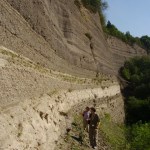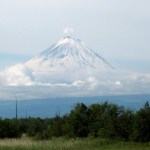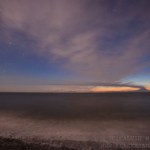USGS
The latest of volcano news from around the world, brought to you by the USGS and Smithsonian Institute Global Volcanism Program (and especially Sally Kuhn Sennert!)
Highlights this week include:
Karangetang in Indonesia produced a couple 3 km/10,000 foot steam-and-ash plumes according to reports from pilots.
Soufriere Hills on the island on Montserrat has had quite a few pyroclastic flows over the last few weeks since the volcano started erupting again. Mix that with some heavy rainfall and lahars were produced as well.
The alert level is still at Orange at Karymsky in Kamchatka, which…
Somehow I missed a week of the SI/USGS Weekly Volcano Activity Reports and almost missed another. Here is this week's update!
Highlights (not including Chaiten, Soufriere Hills or Cleveland) include:
The alert level at Galeras in Colombia was raised to Red after an explosion on September 30 and returned to orange ... and then yellow ... after activity tapered.
Sakurajima in Japan produced 1.8-4.3 km / 6,000-14,000-tall ash-and-steam plumes, along with incandescent tephra that was thrown almost two kilometers from the vent.
Multiple steam-and-ash plumes reached 4.3 km / 14,000 feet at Langila…
The big geology news right now is the M8 earthquake in American Samoa that generated a killer tsunami (which made it all the way to the Bay Area in California).
Mammoth Mountain in California's Long Valley region.
In more benign, volcano-related news:
The aviation alert level at Redoubt in the Alaska has been returned to Green/Normal, which means that for all intents-and-purposes, the eruption that started earlier this year is over. The new dome totals ~91 million cubic yards of lava, slowly adding back to the north side of the volcano.
Eruptions reader Doug C. pointed out to me that there…
A bit of news for your last Monday in September:
Pumice deposits from the ~13,000 year old Laacher See eruption. Image by Erik Klemetti, taken in August 2007.
More press for Dr. Joyce and his campaign to make the people of Australia terrified that volcanoes will destroy them. He warns of "new volcanoes" springing up in the Ballarat region to the northwest of Melbourne (which, incidentally, is where I pointed out might be the most likely place for future volcanism). Yes, sure, we should expect that a new, unknown scoria cone may form in the Newer Volcanic Province - I mean, that is what…
There are a couple article out today concerning volcanoes and the economy, one on the plus side, one on the minus side.
Volcano Buono in Italy near Naples.
First off, nothing like volcanism to get me stoked for buying stuff, eh? Actually, I have to admit, the Volcano Buono mall (yes, mall) in Italy near Naples (and yes, near Vesuvius) is one of the rather more attractive malls I've seen in a long time (above). It is designed to look like a volcano - I suppose it looks most like a monogenetic scoria cone, a little out of place for that part of Italy - but its design was based on trying use…
To the updates!
Batu Tara volcano in Indonesia. The volcano is currently producing small ash plumes.
I was distracted enough by trying to figure out a way to teach about Miller Indices that I plum forgot to post this week's USGS/SI Weekly Volcanic Activity Report. It was a fairly quiet week so you didn't miss much. Enjoy it at your leisure.
Rabaul must be positioned on the globe in such a way that NASA's Aqua satellite always gets a good shot at it. The Earth Observatory posted a new image of the plume from Rabaul and it looks thicker and more ash-laden than the image posted a few weeks ago…
Not much in volcano news, however a lot of earthquake news this morning.
Did anyone else notice that two M6+ earthquakes occurred last night within one minute of each other last night (eastern daylight time)? The first was in the Banda Sea near Indonesia at 01:51:19 UTC (M6.8), the next was in northern Qinhai in China at 01:52:06 UTC (M6.2). I'm guessing that is just the sort of coincidences that occur when you have thousands of earthquakes globally a week, but still an interesting coincidence. There was also a series of earthquakes, all less than M3.7, last night in Oklahoma of all places.…
The slow summer for volcanic eruptions continue. Only 11 updates in this week's USGS/SI report. Thanks again to SI's Sally Kuhn Sennert for compiling the news!
Highlights this week include (not including Kilauea) include:
Tungurahua in Ecuador produced some minor lahars on August 21 to go with steam-and-gas emissions.
Popocatépetl in Mexico produced an ash plume that reached ~8.2 km / 27,000 feet on August 20 and continued to produce steam-and-ash plumes throughout the week following.
Over on the Kamchatka Peninsula, both Koryaksky and Shiveluch produced significant ash plumes (reaching 3-5…
Some brief notes before I dive headlong into the exciting world of faculty orientation!
A small steam plume coming from Turrialba in Costa Rica. Photo taken in August 2007.
There are some preliminary reports of the state of wildlife (and everything) around Kasatochi Island in the Aleutians from the US F&W and USGS team that headed to check out how the island has recovered since last year's eruption. The shoreline has been radically transformed by the ash and although some seabirds have made attempts to nest in the loose ash, it doesn't seem to have been very successful. However, not…
The summit crater at Kilauea in Hawai'i has had a busy summer and now that fall is around the corner (yikes!), there is a bit of new info on activity in the crater.
Halema`uma`u Crater emitting a steam plume in January, 2009.
First off, the NASA Earth Observatory released an image of the steaming crater area of Halema`uma`u. The image captures the new plume of steam and volcanic gases that have been coming from the crater. The latest news reports that the glow (albeit faint) from the underlying magma has returned to the crater after the rockfall earlier this summer. Also, sulfur dioxide…
Busy today with scouting out some field location for the class I'll be teaching this fall. Here's this week's USGS/SI Weekly Volcano Report. The report is a little more eventful than last week's, so enjoy!
Kliuchevskoi Volcano in Kamchatka, taken summer of 2009 by Theresa Kayzar.
Highlights include:
Three volcanoes on the Kamchatka Peninsula are currently producing ash plumes: Kliuchevskoi, Koryaksky and Shiveluch. Shiveluch has been having the most intense eruptions, but the former two are both producing ash-and-steam plumes that reach over 3 km / 10,000 feet.
Talang in Indonesia saws its…
I knew that the minute I said I'd be back to a "regular" posting schedule that I would fail miserably, so maybe the less said, the better.
Cerro Galan caldera in Argentina (taken from space).
Thanks to all the readers who have been avidly discussing a number of fascinating topics over the weekend.
I have seen/read a little bit about the tectonic-forcing mechanism idea for some caldera-style eruptions. The biggest thing to keep in mind is that the caldera-forming event - that is to say the collapse of the roof into the chamber - isn't usually the "trigger" as much as a result of a large…
The Royal Gardens subdivision in Hawai'i being inundated with lava flows during a 1983 eruption of Kilauea. Image courtesy of the USGS.
The game of insurance is everywhere in the news these days so it isn't too surprising to run across this brief article about the perils of getting insured if you live on an active volcano. Many people who live on the big island of Hawai'i face this challenge because a large swaths of the island fall into what is called a "Lava Zone 1", which more or less means that you live someplace that lava is likely to visit in the foreseeable future. Considering that…
We've made it to Ohio! Tomorrow I'll hopefully be returning to regularly scheduled updates, but until then, enjoy this week's SI/USGS Weekly Volcano Report.
Highlights include:
KVERT mentions that seismicity has increased recently at both Kizimen and Kliuchevskoi on the Kamchatka Peninsula.
~4 km / ~13,500 foot steam-and-ash plumes spotted at Colima in Mexico.
Rumbling noises, incandescent ejecta and ~4.3 km / 14,000 foot ash plumes at Fuego in Guatemala. Explosions were increasing as the August began.
It was a busy week in Guatemala, as ash/gas plumes were spotted at Santiaguito and Pacaya…
This is likely my last update until the end of next week sometime, so feel free to use it for any new volcano news you might see. Look for the Erebus Volcano Profile to be posted on Friday sometime, followed by the vote for the next Profile. Next time I post I'll be (back) in the eastern time zone!
With that, I leave you with the latest USGS/SI Weekly Volcano Report.
Highlights (not counting Shiveluch) include:
Small ash plumes were spotted several times from Batu Tara in Indonesia.
Explosions, ashfall and earthquakes were reported at Nevado del Huila in Colombia.
There were reports of…
Your weekly dose of volcanism from the USGS/Smithsonian Global Volcanism Program.
Highlights (not counting Mayon), include:
The activity at Mando Hararo in Ethiopia appears to be a fissure eruption. Ground observations saw a 4-5 kilometers / ~2.5-3 mile fissure with new predominantly 'a'a lava flows that were 2-3 m thick ... the fissure was lined with scoria ramparts 30-50 m high. They did not see any active lava, though.
As some Eruptions readers have pointed out from the OMI SO2 maps, Sarychev Peak (Russia) is still producing gas-and-steam (with some ash) plumes, mostly drifting off to the…
All the volcano news that is fit to print, all thanks to the USGS/Smithsonian GVP!
Highlights (not include Manda Hararo, Kilauea and Mayon) include
San Miguel in El Salvador has been experiencing increased seismicity. The last time the volcano erupted was in 2002.
A pilot spotted a ~10,000 foot / 3 km ash plume emanating from Anak Krakatau in Indonesia.
Another ash plume, this time at Ubinas, Peru, was spotted by pilots rising to ~6.7-9.1 km / 20-30,000 feet.
Explosions were heard from Suwanose-jima in Japan, but no associated ash plumes were spotted.
It sounds like a lava dome has been…
Redoubt steaming in early 2009. Image courtesy of Calvin Hall.
It has been a while since we spoke of Redoubt, but now it seems the reason why might be that the eruption is ending. AVO lowered the Alert Level at Redoubt to Yellow from Orange, indicating that they believe the volcano is less likely to have a large eruption. This doesn't mean that it is out of the question, but rather that signs seem to be pointing to the idea that the eruption is waning.
AVO sums the change:
Seismic, satellite, gas, and deformation observations over the past few weeks indicate that growth of the lava dome at…
Busy busy analysing on the multicollector ICP-MS today (but not busy enough to miss this).
Here's your weekly volcano news roundup from the USGS/Smithsonian GVP.
Highlights (not including Sarychev Peak) include:
Continued dome growth and degassing at Bezymianny in Russia. Starting next year, there will be live webcams for three of the major volcanoes (Bezymianny, Kliuchevskoi, and Shiveluch) on the Kamchatka peninsula! Now, that is exciting news.
The glowing coming from the vent in the Halema'uma'u Crater at Kilauea in Hawai'i is still prominent. The lava levels in the crater have been…
Your weekly dose of volcano news brought you by the Smithsonian Institute GVP and the USGS.
This week's highlights (not counting Sarychev Peak and Turrialba) include:
13,000 foot / 4 km ash plumes from Rinjani in Indonesia. This is part of the continuing eruption there.
The alert level was lowered at Galeras, Colombia to "Orange" after intense eruptions last week.
The current lava dome at Redoubt is 1 km long, 460 m wide, and 200 m high according to the latest images from the Alaskan volcano.
18,000-23,000 foot / 4.8-7.7 km ash plumes from Shiveluch in Kamchatka, along with thermal anomalies…


